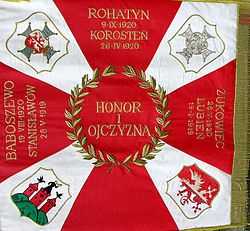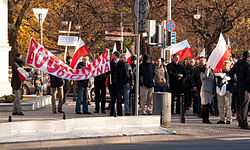Bóg, Honor, Ojczyzna


God, Honour, Fatherland[lower-alpha 1] (Polish: Bóg, Honor, Ojczyzna) or Honour and Fatherland (Honor i Ojczyzna) is one of the unofficial mottos of Poland. It is commonly seen as the motto of the military of Poland, and has been confirmed as such by several Polish legal decrees. It traces its history to the era of partitions of Poland and Polish service in Napoleonic army.
Etymology
The noun ojczyzna is derived from ojciec (the Polish word for "father"), which is why "fatherland" is a common translation of the term. Sometimes it is interpreted as literally "land of the fathers". However, ojczyzna itself is feminine - just like Polska (the endonym for Poland) - so it can also be translated as motherland with a similar degree of accuracy. To avoid confusion and remain neutral, some people translate ojczyzna simply as "homeland" therefore avoiding the fatherland/motherland preference. Terms for "homeland" with similar spelling and pronunciation to ojczyzna appear in other Slavic languages as well, for example the Russian отчизна or Czech otčina.
History
The phrase "Honour and Fatherland" can be traced to the slogans and banners of Polish revolutionaries of the 19th century, fighting to regain Polish independence following the partitions of Poland.[2] This is also the motto of the French Legion of Honour, instituted by Napoleon in 1802.[3] It is likely that the phrase was brought to Poland by the soldiers of the Napoleonic-era Polish legions.[2][4][5] It was introduced as phrase to be used on the banners of the newly reconstituted Polish military of the Second Polish Republic in 1919.[6] The word God was officially added to the standards, preceding words Honour and Fatherland, by the decree of the Polish government-in-exile in 1943.[7] This decree remained in force till it was changed by the communist government of the People's Republic of Poland in 1955 to "For Our Fatherland the People's Republic of Poland" ("Za naszą Ojczyznę Polską Rzeczpospolitą Ludową").[8] Following the fall of communism, the "God, Honour, Fatherland" phrase was restored by the government of the Third Polish Republic in 1993.[9]
Significance
The motto is interpreted as reconfirming the Constitution of Poland's clause about the citizen's duty to serve the Fatherland (ojczyzna), with the social contract allowing exceptions honour and faith (Ojczyźnie wszystko, prócz miłości Boga najwyższego i Honoru).[10][11] It is one of the symbols connecting Polish patriotism to (Catholic) religiosity.[12]
The inclusion of God in the motto has been occasionally seen as controversial, particularly by those who see it as infringing upon the separation of church and state.[13][14]
See also
- For our freedom and yours ("Za wolność Waszą i Naszą")
| Wikimedia Commons has media related to Bóg, Honor, Ojczyzna. |
Notes
- ↑ Polish language term ojczyzna directly translates as Fatherland, but it is also occasionally translated as Motherland, thus leading to the rendering of this motto in English as "God, Honor and Motherland". See for example the translation as used in Wierzbicka (1992).[1]
References
- ↑ Department of Linguistics Australian National University Anna Wierzbicka Reader (1992). Semantics, Culture, and Cognition: Universal Human Concepts in Culture-Specific Configurations: Universal Human Concepts in Culture-Specific Configurations. Oxford University Press. p. 443. ISBN 978-0-19-536091-2.
- ↑ 2.0 2.1 Aleksander Gella (1989). Development of Class Structure in Eastern Europe: Poland and Her Southern Neighbors. SUNY Press. p. 154. ISBN 978-1-4384-0392-2.
- ↑ Jean-Denis G.G. Lepage (2010). French Fortifications, 1715-1815: An Illustrated History. McFarland. p. 24. ISBN 978-0-7864-5807-3.
- ↑ Rocznik Mazurka Dąbrowskiego (in Polish). Graffiti BC. 2001. p. 65.
- ↑ Jacek Macyszyn; Wojciech Krajewski; Krzysztof Paleski (2005). Napoleon i Polacy (in Polish). Dom Wydawniczy "Bellona". p. 18. ISBN 978-83-11-10121-0.
- ↑ "art. 7 ust. 3 i wzór nr 5 do Rozporządzenia Prezydenta Rzeczypospolitej z dnia 13 grudnia 1927 r. o godłach i barwach państwowych oraz o oznakach, chorągwiach i pieczęciach (Dz. U. z 1927 r. Nr 115, poz. 980 ze zm.)". Internetowy System Aktów Prawnych. Retrieved 2013-08-19.
- ↑ Jerzy Murgrabia (1990). Symbole wojskowe Polskich Sił Zbrojnych na Zachodzie, 1939-1946 (in Polish). Wydawn. Bellona. p. 29. ISBN 978-83-11-07825-3.
- ↑ "art. 10 ust. 4 i załącznik nr 2 do Dekretu z dnia 9 listopada 1955 r. o znakach Sił Zbrojnych (Dz. U. z 1955 r. Nr 47, poz. 315 ze zm.)". Internetowy System Aktów Prawnych. Retrieved 2013-08-19.
- ↑ "art. 14 ust. 3 i załączniki nr 5 i 5a do Ustawy z dnia 19 lutego 1993 r. o znakach Sił Zbrojnych Rzeczypospolitej Polskiej (Dz. U. z 1993 r. Nr 34, poz. 154 ze zm.)". Internetowy System Aktów Prawnych. Retrieved 2013-08-19.
- ↑ Waldemar Kitler (2011). Bezpieczeństwo Narodowe RP: podstawowe kategorie, uwarunkowania, system (in Polish). Akademia Obrony Narodowej. p. 242. ISBN 978-83-7523-159-5.
- ↑ Henryk Binkowski (2003). Wojsko i obronność w działalności Sejmu RP: 1989-2001 (in Polish). Wydawn. Sejmowe. p. 66. ISBN 978-83-7059-585-2.
- ↑ Roman Zawliński (1996). Poradnik językowy (in Polish). Państwowe Wydawn Naukowe. p. 27.
- ↑ Dominik Zdort (2012). Kompendium patriotyzmu (in Polish). Wydawnictwo M. p. 94. ISBN 978-83-7595-481-4.
- ↑ Adam Michnik (1995). Diabeł naszego czasu: publicystyka z lat 1985-1994 (in Polish). Niezależna Oficyna Wydawnicza. p. 80.